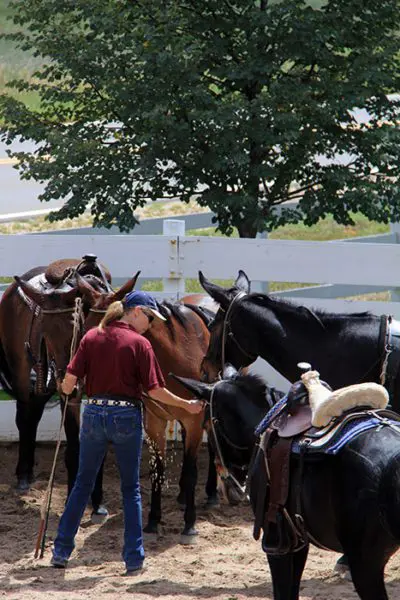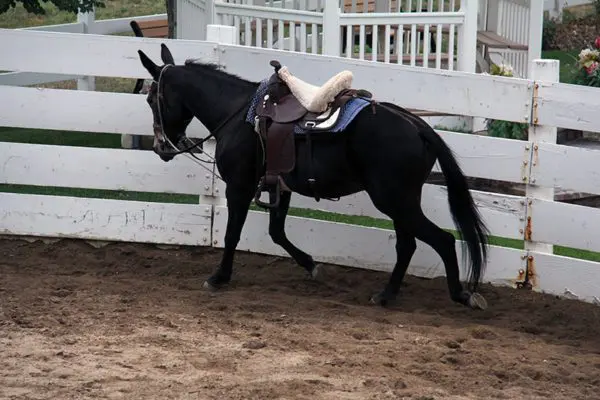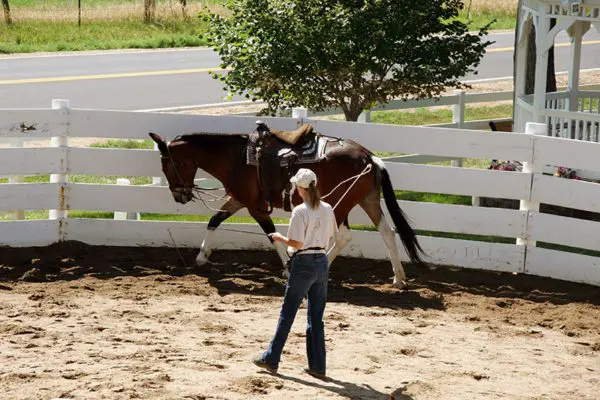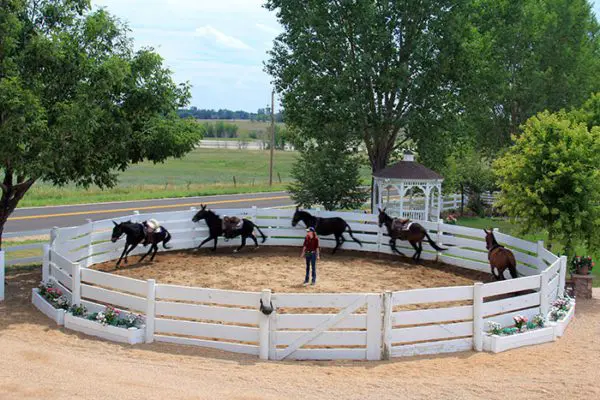MULE CROSSING: Keys To Successful Training, Part 2: Attitude and Approach
By Meredith Hodges
Establishing a bond Are you having problems getting the same response from your equine that trainers do? This two-part article is designed to help you learn to successfully train your own equine.
 Training isn’t just a way to teach your equine to do certain “movements,” but a way for you to help him to grow physically and mentally healthy, and to enable him to learn to cope with the demands that will be put on him during his lifetime—much like raising a child to grow up to be a healthy and productive adult.
Training isn’t just a way to teach your equine to do certain “movements,” but a way for you to help him to grow physically and mentally healthy, and to enable him to learn to cope with the demands that will be put on him during his lifetime—much like raising a child to grow up to be a healthy and productive adult.
 The subtleties in your attitude and approach, along with a solid knowledge base, can make all the difference in your training program. Whether your equine is a foal or an older animal that you have just obtained, whether he is trained or untrained, the process is the same and it’s never too late to get started with the right kinds of expectations in mind. You are creating a bond, developing the foundation for a healthy friendship, and setting the ground rules that will dictate the positive extent of your continuing relationship with your animal. It is important to be an active participant in your animal’s training. After all, you wouldn’t have someone else make a friend for you. You’d do it yourself—one-on-one.
The subtleties in your attitude and approach, along with a solid knowledge base, can make all the difference in your training program. Whether your equine is a foal or an older animal that you have just obtained, whether he is trained or untrained, the process is the same and it’s never too late to get started with the right kinds of expectations in mind. You are creating a bond, developing the foundation for a healthy friendship, and setting the ground rules that will dictate the positive extent of your continuing relationship with your animal. It is important to be an active participant in your animal’s training. After all, you wouldn’t have someone else make a friend for you. You’d do it yourself—one-on-one.
Feeding What you feed your equine and how well his health is maintained will determine how responsive he will be to training. Although some popular feeds may build body mass more rapidly and may seem to be promoting healthy physical development, these high-protein feeds can also have negative effects, especially on Longears. Often, with high-protein feeds, an equine’s physical growth is accelerated and becomes disproportionate to his normal growth on simple equine feed like oats and grass hay. His mental growth may also be adversely affected with high-protein feeds, as they can cause anxiety and limited attentiveness. If the animal is feeling anxious or inattentive, or if parts of his body become sore from unnatural growth spurts or inappropriate exercise, he may be less likely to perform in an enthusiastic and energetic way.
I have found that equines do best on a mixture of crimped oats (1-2 lbs. for the average-sized saddle equine) mixed with a vitamin concentrate such as Sho-Glo (1 oz.), and Mazola corn oil (1 oz.) for hooves and coat, and for digestive tract regularity. Draft animals would get twice as much and minis get ¼ to ½ as much. After rescuing Rock and Roll, the 17 and 18-year old Drfat mules, we added the Hoof Power supplement to the oats mix which has worked well with all the equines we have that are over 25 years old. This once-a-day oats mix regimen should be fed in the evenings and supplemented with grass hay twice a day, with the amount of hay being increased or decreased to monitor desired weight gain or loss. As a reward for positive responses in training, your animal should get the additional crimped oats so he will get immediate energy when he needs it the most, during the training process. Crimped oats, unlike any other equine reward, is also something that the animal will continue to work for without tiring of it.
Apples, carrots, horse treats and the like are things on which they can get sated and are not necessarily good for your equine in excess. Some of these “treats” can even have the same effect that candy has on children. An animal may experience residual affects such as an upset digestive tract, a short attention span or even hypertension, all of which can have a negative affect on training. Feeding the same way, and at the same times each day, is not only healthy, but it fosters confidence and trust within your animal because it makes him feel good. He learns without question that he can depend on you for his welfare and that his efforts will be rewarded with his favorite reward of crimped oats.
Consideration Being patient, kind and considerate toward your equine and spending a little more time developing a good  solid foundation with him before moving on to more elaborate maneuvers will yield better results. Remember to always be aware of your equine’s physical, mental and emotional responses during training. For instance, you may think that, once your mule is moving around the round pen at all three gaits with a reverse, he is ready to begin riding, but this may not necessarily be true. Considering that it takes years to really condition muscles to their maximum strength, six to eight months of doing round pen exercises is not really that long a period of time. If you don’t spend at least six months on flatwork leading training and six months on obstacle leading lessons to promote strength and balance in good posture, you can greatly hinder your equine’s ability to perform in the round pen on the circle. In turn, spending less than six to eight months in the round pen will not produce the best results in muscle development. If you move through conditioning too fast, it will affect your animal’s mental attitude toward training and he will very likely experience soreness and emotional depression. As a result, he will most likely become resistant to training.
solid foundation with him before moving on to more elaborate maneuvers will yield better results. Remember to always be aware of your equine’s physical, mental and emotional responses during training. For instance, you may think that, once your mule is moving around the round pen at all three gaits with a reverse, he is ready to begin riding, but this may not necessarily be true. Considering that it takes years to really condition muscles to their maximum strength, six to eight months of doing round pen exercises is not really that long a period of time. If you don’t spend at least six months on flatwork leading training and six months on obstacle leading lessons to promote strength and balance in good posture, you can greatly hinder your equine’s ability to perform in the round pen on the circle. In turn, spending less than six to eight months in the round pen will not produce the best results in muscle development. If you move through conditioning too fast, it will affect your animal’s mental attitude toward training and he will very likely experience soreness and emotional depression. As a result, he will most likely become resistant to training.
Pay attention to how many laps your equine does in each direction and at each gait: how many reverses to the left, and then how many to the right. Take this opportunity to assess whether he will need a few more laps on the side that is weaker. If you make these things your priority, when you finally do start riding him, his straight lines will be straighter, his turns smoother and his reverses and stops more balanced, and with minimal effort. As your equine grows stronger and more mentally and physically confident, the upper-level movements will come faster and easier than did the basic foundation training, which is why it’s so important to take your time and be patient—especially during foundation training. Another way to show consideration for your animal is to investigate valuable therapeutic tools like equine massage and chiropractics.
Structured exercises Even if you do not plan to show your equine, he must be strong enough to be able to perform easily, even on something as seemingly simple as trail riding. Different exercises build different muscle groups, so it is important to  know what exercises you should begin with and which exercises should follow. Don’t let yourself get sucked into drilling on something that just isn’t working. If you run into problems and things aren’t working out properly, just go back and try something that is similar in its demand but simpler for you and/or your equine to execute. Sometimes, it is just a manner of approaching the problem differently or leaving it to another day. Like humans, equines have their own individual ways of learning and it’s up to you to figure out what works best with your particular equine on any given day. You can find my suggested approaches to this in my DVD series, Training Mules & Donkeys and Equus Revisited. Note: Don’t forget to reward your animal for positive behavior.
know what exercises you should begin with and which exercises should follow. Don’t let yourself get sucked into drilling on something that just isn’t working. If you run into problems and things aren’t working out properly, just go back and try something that is similar in its demand but simpler for you and/or your equine to execute. Sometimes, it is just a manner of approaching the problem differently or leaving it to another day. Like humans, equines have their own individual ways of learning and it’s up to you to figure out what works best with your particular equine on any given day. You can find my suggested approaches to this in my DVD series, Training Mules & Donkeys and Equus Revisited. Note: Don’t forget to reward your animal for positive behavior.
Body language and verbal communication Learn to be consistent with your verbal commands and don’t leave them out. Most equines can learn to identify words and will usually respond much more readily to verbal commands than to cues alone, so give your equine this “verbal cue” advantage.
In the beginning, keep your words simple and consistent (“walk,” “trot,” “canter,” “reverse,” “whoa”). As your equine becomes more familiar with them, you can include additional words (“move over,” “go to the rail,” “easy,” and so forth). By the time he is an adult and has gone through this kind of training, he should begin to understand almost anything you might have to say. It is much like a child who first learns his ABCs, then words, then sentences and, eventually, entire paragraphs. Pay attention to yourself as you are training. How you feel affects your animal, which will dictate how he reacts to you. For instance, if you are a little nervous about being around your equine, he will sense this and may think there is a reason for him to be nervous, too. If you are happy, relaxed and patient about doing things, you will elicit a better response from your equine. Attitude is everything, so do whatever you need to do to keep the experience interesting and enjoyable for both of you.
 Benefits of group lessons Equines can learn from each other, so it can be beneficial to work them together. When you are working with foals, it is helpful to take “Mom” along or have her tied nearby during training sessions. Green animals often do better on the trails during the first year if they are ridden along with well-trained trail animals. If you have multiple animals to keep conditioned, you can even lunge them together, provided your work in the round pen has been consistent with each of them separately from the beginning. In driving training, the “group lesson” idea of hitching young animals with the “old pros” has been a common practice for many years. Lunging “teams” together can also provide beneficial exercise. Speaking of “old pros,” it is to your advantage to find a local instructor/trainer with whom you can periodically take lessons. This gives you a way to check to make sure you stay on the right track and continue to improve your own skills. Lists of trainers and instructors can be obtained from the United States Equestrian Federation.
Benefits of group lessons Equines can learn from each other, so it can be beneficial to work them together. When you are working with foals, it is helpful to take “Mom” along or have her tied nearby during training sessions. Green animals often do better on the trails during the first year if they are ridden along with well-trained trail animals. If you have multiple animals to keep conditioned, you can even lunge them together, provided your work in the round pen has been consistent with each of them separately from the beginning. In driving training, the “group lesson” idea of hitching young animals with the “old pros” has been a common practice for many years. Lunging “teams” together can also provide beneficial exercise. Speaking of “old pros,” it is to your advantage to find a local instructor/trainer with whom you can periodically take lessons. This gives you a way to check to make sure you stay on the right track and continue to improve your own skills. Lists of trainers and instructors can be obtained from the United States Equestrian Federation.
To learn more about Meredith Hodges and her comprehensive all-breed equine training program, visit LuckyThreeRanch.com, MEREDITH HODGES PUBLIC FIGURE Facebook page, or call 1-800-816-7566. Check out her children’s website at JasperTheMule.com. Also, find Meredith on Pinterest, Instagram, MeWe, YouTube and Twitter.
Covered in TRAINING MULES & DONKEY: A LOGICAL APPROACH TO TRAINING, TRAINING WITHOUT RESISTANCE and EQUUS REVISITED at www.luckythreeranchstore.com.
© 2004, 2005, 2013, 2016, 2018, 2024 Lucky Three Ranch, Inc. All Rights Reserved.

